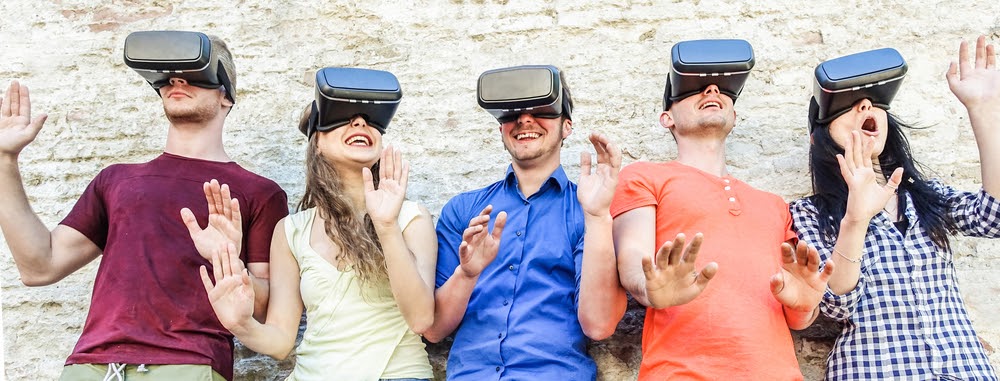Why Virtual Reality Goggles are Getting Cheugy
Pumpkin spiced lattes, skinny jeans, side parts, graphic tees. The commonality? Their cheugy status. While these once cool trends were often associated with the younger generation known as Millennials, Generation Z is up and coming. They don’t wear skinnies. They prefer the middle part. And maybe they’re also not really donning virtual reality goggles.
Yes, we might need to admit an uncomfortable tech truth. Virtual reality goggles might be getting cheugy! Except Millennials never really embraced virtual reality with zeal. The New York Times was a bit kinder in noting that the tech is “niche.”
A few years back, Inc. wrote about how virtual reality could be used to reach Gen Z. And while this immersive tech is the type of experience Gen Z likes, the problem with virtual reality is the gateway into it: the virtual reality goggles.
The headsets or goggles—call them what you will—have never really been sleek or stylish. They’re clunky. They often connect with cumbersome wiring. Some are insanely expensive. Even years after Inc. wrote about the allure of virtual reality and augmented reality, not much has changed for the design of virtual reality headsets.
But augmented reality? That’s another story.
Tech writers aren’t necessarily buzzing consistently about virtual reality headsets. They are, however, waiting for the drop of consumer-driven augmented reality glasses. These may be the promise of the future. The sleek visual link to a fully immersive world. And one that isn’t tethered to wires or other equipment.
Virtual reality goggles might need to be cancelled. At least in their common iterations. They’re evolving but not really evolving. Their clunkiness has not really improved over time, and, while this is fine for enterprise uses like employee training and simulations, is it really what the younger audience is desiring?
Oculus is one of the most popular virtual reality consumer headsets on the market. It’s also the most affordable. In the last quarter of 2020, Statista reported that more than a million headsets were sold. In the first quarter of 2021, sales dropped to around 850,000. Fourth quarter, of course, correlates with the holidays.
The sales drop isn’t horrific. Oculus isn’t hurting. But does the traditional headset need a facelift? A redesign? And could that be in the future?
Oculus is owned by Facebook, now known as Meta. The company has been very outspoken—as has its founder—about the future of immersive technology. Meta is interested in creating an entire metaverse, but the question is will virtual reality be a part of it? Or will augmented reality augment this universe?
Meta’s home page includes both augmented and virtual reality possibilities. Oculus also is included. But will the standard Oculus headset be the gateway into Meta’s metaverse? Or will consumers see something much more astounding and cutting edge from Meta?

The Problem with Virtual
Virtual reality comes with a few problematic features for some consumers. Virtual reality isn’t—right now—necessarily financially accessible. Oculus tends to be one of the more budget-friendly headsets at around $300, but for many individuals and families this isn’t affordable especially since virtual reality is largely seen as entertainment.
Consumers don’t need virtual reality. It isn’t essential to everyday life. Thus, the investment really isn’t alluring for those who can’t afford it. In order for technology to really become mainstream, it needs to be equitable and affordable but it also needs to be necessary.
Right now, virtual reality isn’t a necessary technology. It isn’t a smartphone. It isn’t a computer. Virtual reality isn’t yet a means of connection.
Virtual reality also isn’t embraceable for every consumer. The technology requires a headset to immerse into the experience, and this experience tricks the brain into thinking that movement or other actions are occurring when the body remains at rest. The issue with this is that some individuals suffer from nausea or other sickness because of sensory miscommunication.
Their brain and body aren’t in sync. They feel nauseated, they may suffer from headaches or feel dizzy. Similar reactions can happen with modern 3D movies.
The headsets are the only way to access the virtual realm. And, for some consumers, the discomfort and price of the headset just isn’t worth the admission into a virtual realm.
While virtual reality headsets have improved over the years, they’re still bulky and clunky. And many are still tethered by wires, which can make those models cumbersome.
The Metaverse and Virtual and Augmented Reality
So is virtual reality done? No! Virtual reality as a technology isn’t cheugy. Virtual reality isn’t the problem; the headsets are the problem. The issues of access are the problem. And this is where the metaverse and the buzz about glasses enter the picture.
Creating an entire metaverse isn’t going to happen overnight. And how that world will look is only really understood by Meta and the imagination of those who will be creating it. Yet, if consumers and younger generations are going to want to jump into this realm, the access might need to be a bit more visually appealing…and financially feasible.
If the metaverse is going to be the future of connection, the access into it will need to be comfortable for the consumer. And, obviously, not cost prohibitive.
The beginning of this technology will probably be experienced by those who can afford the technology to access it. However, if the metaverse or this type of technology becomes mainstream, tech companies might develop more affordable glasses to see into this world.
As Meta is developing its metaverse, though, what of Apple, Google, Microsoft and others? Could there be multiple different realms branded by each company? And would or could each company offer its own pair of either augmented or virtual reality glasses that can be used to immerse into these experiences?

Augmented Reality Glasses
The development of augmented reality glasses may change the immersive consumer experience. Microsoft has stated its intent to create a consumer version of HoloLens, which features augmented reality.
Most everyone knows Meta’s commitment to immersive technology. And the buzz around augmented reality glasses from Apple has been around for quite some time.
Glasses—sleek and probably unique to each company—might be what usurps the virtual reality goggles or headset. And, again, this isn’t assuming that virtual reality will go away or disappear. However, accessing the technology could change.
Perhaps augmented reality glasses give way to glasses that also allow entrance into virtual reality. Or maybe these glasses become the access point to mixed reality experiences.
The race is on between the tech giants regarding who will debut the first consumer-driven augmented reality glasses. However, this debut could mark the turning point for augmented reality to solidify the virtual reality goggle’s cheugy status.
The debut of augmented reality glasses also could be a call to tech companies for redesigning virtual reality headsets to make them sleeker, less cumbersome and, hopefully, more affordable, too…and save them from cheugy.
Virtual Reality without the Headset
For consumers who want to experience virtual reality without donning those cumbersome and not-so-cool headsets or goggles, there are a few options. Unfortunately, those options aren’t true virtual reality.
The definition of virtual is sometimes very loose. Some consumers consider anything that doesn’t take place in-person to be ‘virtual.’ Like virtual learning or virtual meetings. True virtual reality takes place in a virtual realm; everything in this realm is graphically generated. There isn’t any real world overlap.
Without a headset or goggles, entering the virtual realm isn’t really feasible. However, those who want an immersive experience that isn’t virtual reality can opt for augmented reality experiences.
Augmented reality is very much accessible for most consumers; all that’s needed is a smartphone or tablet. Explore augmented reality games or use augmented reality tools to preview products.
Consumers experience augmented reality by using their phone or tablet camera to view the real world; the app will display the augmented reality data into the real environment. Augmented reality overlays digital graphics on top of the real world; it can sometimes mix fantasy with reality. Pokemon might not really exist, but thanks to augmented reality they appear in the real world.
While virtual reality isn’t accessible without a headset or goggles, the immersive experience of augmented reality can be enjoyed by most consumers. Augmented reality also can be embedded into Snapchat and other social media posts.
The Evolution of Reality
Reality is evolving into augmented and virtual realms. While the evolution of virtual reality headsets seems slightly stagnated, the pursuit of augmented reality technology including glasses may propel interest in redesigning those old clunky headsets.
If and when augmented reality glasses become a reality, this technology could be the new ‘must have’ item. The new tech darling.
Virtual reality isn’t cancelled, though. And the tech itself isn’t cheugy. However, the old clunky styling of the access into the virtual realm has, perhaps, entering its tech expiration.
Virtual reality needs a redesign. For virtual reality to fully hit mainstream popularity, for it to really be a ‘must have,’ it also needs to be necessary. It isn’t. Not yet. Could the metaverse change this? That remains to be seen.
But consumers also could be faced with many virtual and augmented realities branded by different tech players. And they all could have their own glasses. Hopefully, those glasses will be worth the wait…and worth the wear. And, ideally, engineers will have declunked the cheugy virtual reality goggles and allowed them to evolve into something that is both accessible and stylish.
Recent Posts
Categories
Luxury Cars
Trucks
Sedans
